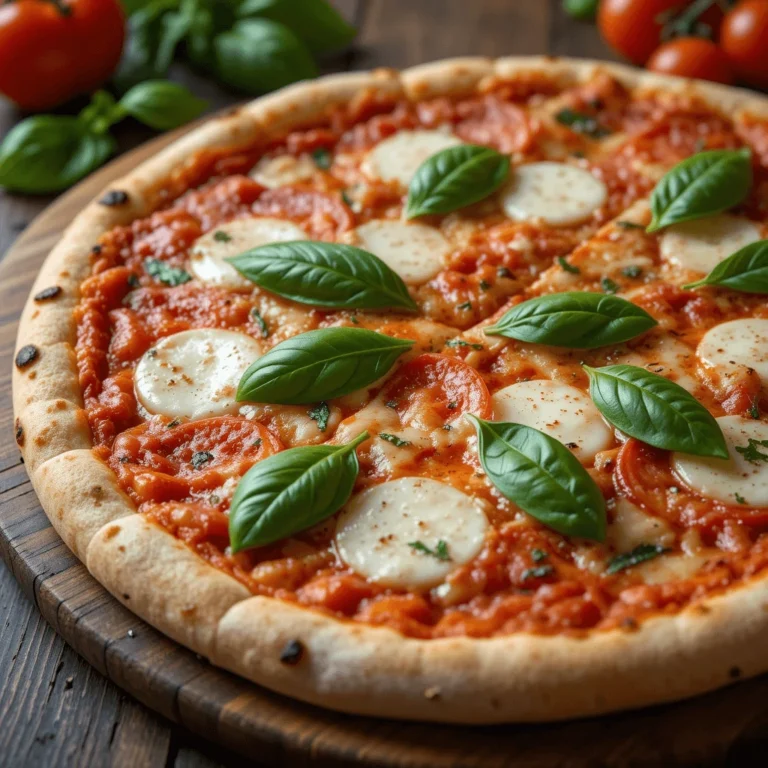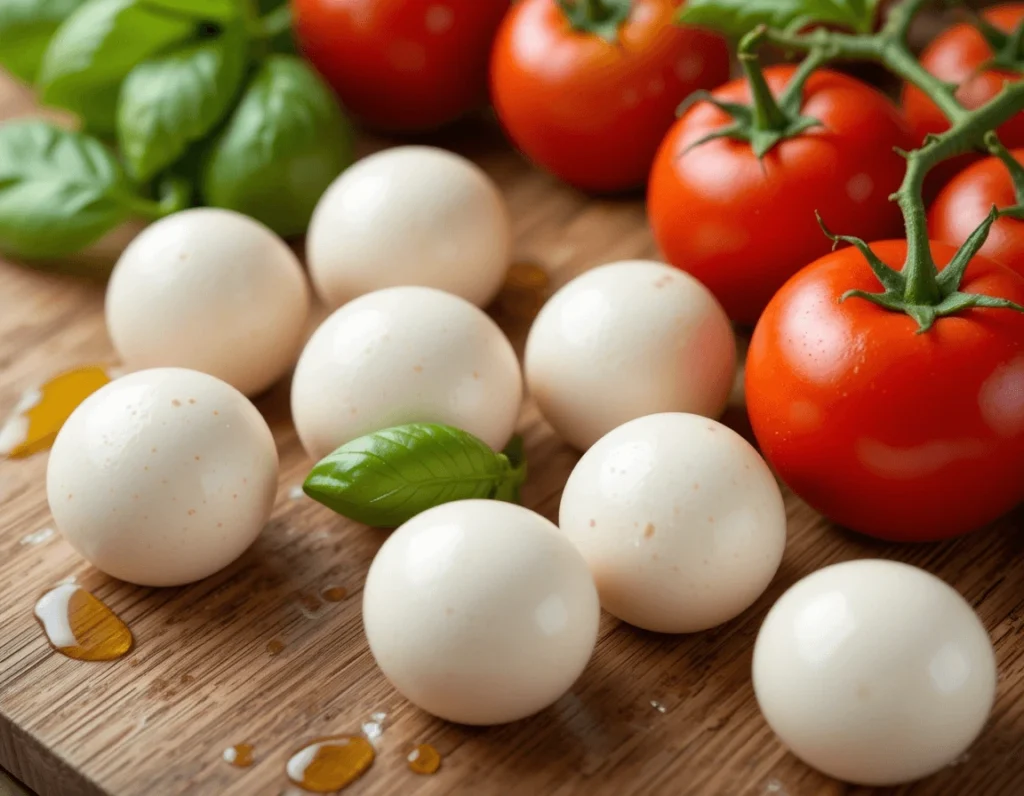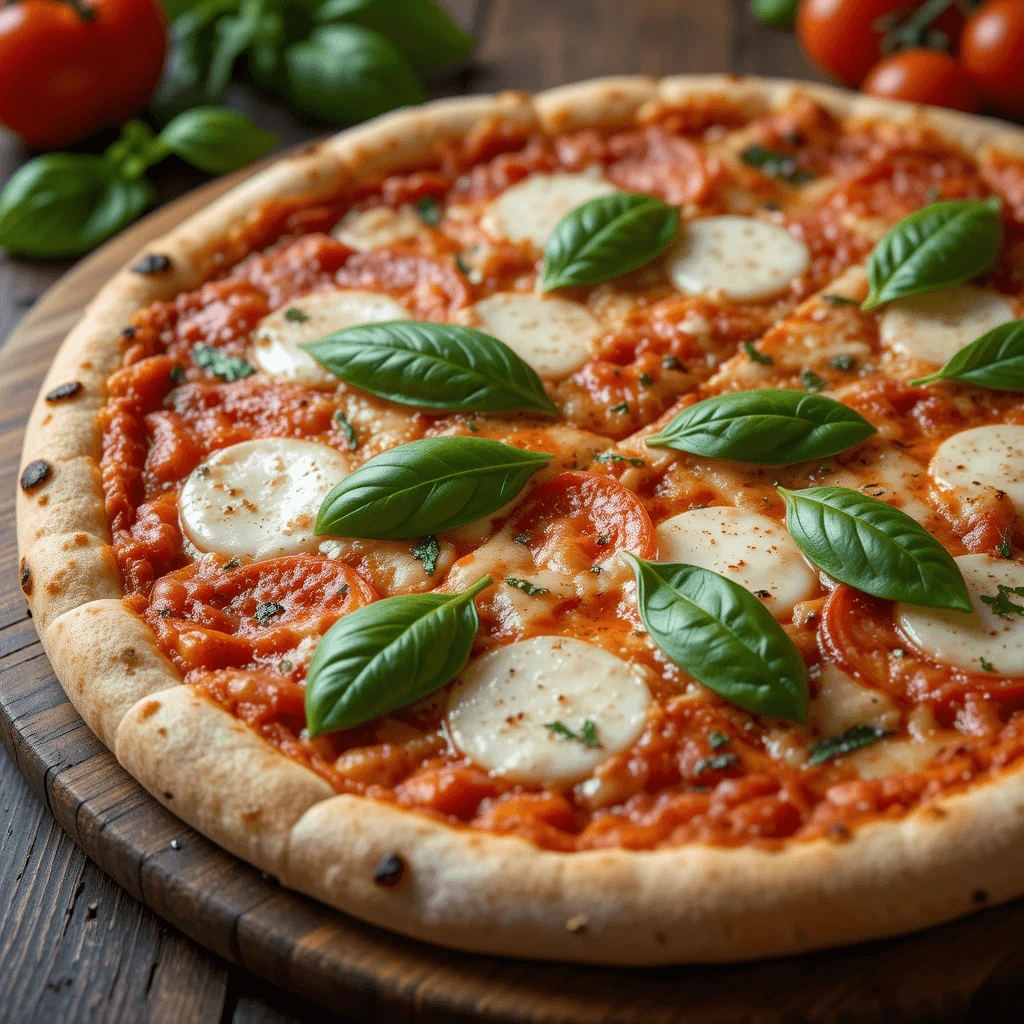One of the reasons Margherita pizza is so beloved worldwide is because of its simplicity. The recipe doesn’t require many ingredients, but getting the right balance of flavors is key to a perfect pizza. Whether you’re using a wood-fired oven or a regular home oven, here’s a step-by-step guide to making the perfect Margherita pizza at home.
Print
How to Make the Perfect Margherita Pizza at Home
Margherita pizza is a simple yet delicious dish that captures the essence of Italian cuisine. With its thin crust, fresh mozzarella, sweet tomato sauce, and aromatic basil, this pizza is a classic that can be made easily at home.
- Total Time: 1 hour 25 minutes
- Yield: 1 pizza 1x
Ingredients
- 500g all-purpose flour
- 1 tsp dry yeast
- 1 tsp salt
- 1 tsp sugar
- 325ml warm water
- 1 tbsp olive oil
- 1 can of San Marzano tomatoes (or fresh, ripe tomatoes)
- 1 tsp olive oil
- 1 garlic clove (optional)
- Salt, to taste
- Fresh basil (optional)
- 250g fresh mozzarella cheese
- Fresh basil leaves
- Extra virgin olive oil
Instructions
- Combine the flour, yeast, salt, and sugar in a large bowl.
- Slowly add the warm water and olive oil, mixing to form a dough.
- Knead the dough for about 10 minutes, until it becomes smooth and elastic.
- Cover the dough and let it rest for 1 hour to rise.
- After the dough has doubled in size, punch it down and roll it out to about 12 inches in diameter.
- For the sauce, crush the tomatoes and heat olive oil in a pan. Sauté garlic (optional), add the tomato sauce, season with salt, and cook on low for about 10 minutes. Add basil if desired.
- Preheat your oven to 250°C (480°F). Roll out your dough onto a piece of parchment paper. Spread a thin layer of tomato sauce on the dough, leaving a small border around the edges.
- Tear the mozzarella into small chunks and scatter them across the sauce.
- Bake the pizza in the preheated oven for 7-10 minutes or until the crust is golden and the cheese is bubbly and slightly browned.
- Once out of the oven, add fresh basil leaves and a drizzle of extra virgin olive oil for the perfect finish.
Notes
For an even deeper flavor, let your dough rise for up to 24 hours in the fridge. Make sure to use fresh mozzarella and high-quality tomatoes for the best results.
- Prep Time: 1 hour 15 minutes
- Cook Time: 10 minutes
- Category: Main Course
- Method: Baking
- Cuisine: Italian
Nutrition
- Serving Size: 1 slice
- Calories: 250
- Sugar: 4g
- Sodium: 450mg
- Fat: 10g
- Saturated Fat: 4g
- Unsaturated Fat: 5g
- Trans Fat: 0g
- Carbohydrates: 30g
- Fiber: 2g
- Protein: 12g
- Cholesterol: 25mg
Keywords: margherita pizza, pizza, italian pizza, homemade pizza, mozzarella, basil
Prepare the Pizza Dough
The dough is the foundation of your pizza. If you want a chewy, crispy crust, it’s essential to get the dough right.
- Ingredients for Pizza Dough:
- 500g all-purpose flour
- 1 tsp dry yeast
- 1 tsp salt
- 1 tsp sugar
- 325ml warm water
- 1 tbsp olive oil
- Instructions:
- Combine the flour, yeast, salt, and sugar in a large bowl.
- Slowly add the warm water and olive oil, mixing to form a dough.
- Knead the dough for about 10 minutes, until it becomes smooth and elastic.
- Cover the dough and let it rest for 1 hour to rise.
- After the dough has doubled in size, punch it down and roll it out to about 12 inches in diameter.
Tip: Let your dough rise for a longer period (up to 24 hours in the fridge) to develop a deeper flavor.

Table of Contents
Table of Contents
Make the Tomato Sauce
For an authentic Margherita pizza, simplicity is key. The sauce is made from high-quality, fresh ingredients. Traditionally, San Marzano tomatoes are used for their sweet and less acidic taste.
- Ingredients for Tomato Sauce:
- 1 can of San Marzano tomatoes (or fresh, ripe tomatoes)
- 1 tsp olive oil
- 1 garlic clove (optional)
- Salt, to taste
- Fresh basil (optional)
- Instructions:
- If using canned tomatoes, crush them by hand or with a blender to create a smooth sauce. If using fresh tomatoes, blanch and peel them before blending.
- Heat olive oil in a pan and lightly sauté garlic until fragrant (optional).
- Add the tomato sauce to the pan, season with salt, and cook on low for about 10 minutes to reduce slightly.
- If you like, add a couple of fresh basil leaves for an aromatic finish.
The key is to keep the sauce simple and fresh, allowing the tomatoes to shine.
Assemble Your Margherita Pizza
Once the dough is ready and your sauce is prepared, it’s time to assemble your Margherita pizza.
- Ingredients for Topping:
- 250g fresh mozzarella cheese
- Fresh basil leaves
- Extra virgin olive oil
- Instructions:
- Preheat your oven to its highest setting (around 250°C or 480°F). If you have a pizza stone, place it in the oven while preheating.
- Roll out your dough onto a piece of parchment paper (this makes it easier to transfer the pizza to the oven).
- Spread a thin layer of tomato sauce evenly on the dough, leaving a small border around the edges.
- Tear the mozzarella into small chunks and scatter them across the sauce.
- Bake the pizza in the preheated oven for about 7-10 minutes or until the crust is golden and the cheese is bubbly and slightly browned.
- Once out of the oven, add fresh basil leaves and a drizzle of extra virgin olive oil for that signature finish.
Tips for the Perfect Margherita Pizza
Creating the perfect Margherita pizza requires attention to detail. Here are some expert tips to elevate your pizza-making game.
1. Use Fresh Ingredients
- Always opt for fresh mozzarella rather than pre-shredded cheese. Fresh mozzarella gives a creamier, more authentic flavor that’s essential for Margherita pizza.
- Use high-quality extra virgin olive oil for drizzling on top of your pizza. It enhances the flavor and adds richness.
2. Don’t Overload the Toppings
- The beauty of Margherita pizza lies in its simplicity. Avoid the temptation to add too many toppings. The focus should remain on the mozzarella, tomatoes, and basil.
3. Bake at High Heat
- Margherita pizza requires a hot oven to achieve that perfect crisp crust. Make sure your oven is preheated to at least 250°C (480°F). Using a pizza stone can also help achieve a crispier base.
4. Use a Wood-Fired Oven for Authenticity
- If you have access to a wood-fired oven, it will add an extra layer of flavor that’s hard to replicate with a conventional oven. The intense heat of the wood fire cooks the pizza quickly, creating that perfect, slightly charred crust.
5. Let the Dough Rest
- For the best pizza dough, let it rest and rise slowly. This allows the gluten to develop, giving your dough that desirable chewy texture.
How to Serve Your Margherita Pizza
Now that you’ve made the perfect Margherita pizza, it’s time to serve it up!
Serving Suggestions:
- Serve your Margherita pizza immediately after baking while the mozzarella is still melted and bubbly.
- Pair your pizza with a simple side salad or a glass of Italian red wine, such as Chianti or Sangiovese.
- You can also top the pizza with extra toppings like arugula or a light drizzle of balsamic glaze for added flavor.
Margherita Pizza Variations Around the World
While Margherita pizza is traditionally an Italian dish, it has undergone various adaptations worldwide. Here are a few variations of Margherita pizza that you might encounter:
Neapolitan Margherita Pizza
- The Neapolitan Margherita pizza is the most traditional version, made with San Marzano tomatoes, fresh mozzarella di bufala, and basil. It’s cooked in a wood-fired oven at a high temperature, resulting in a slightly charred, soft crust.
New York-Style Margherita Pizza
- New York-style Margherita pizza has a thicker, crispier crust. While it still follows the traditional topping recipe, the crust is more substantial and often larger, allowing for larger slices.
Brazilian-Style Margherita Pizza
- In Brazil, Margherita pizza often has a spiced crust and might be topped with oregano or extra herbs to enhance the flavor profile.
Chicago-Style Margherita Pizza
- A deep-dish version of Margherita pizza can be found in Chicago. It has a thick, buttery crust and is more similar to a pizza pie than the traditional thin-crust Italian version.
FAQS:
How to make Margherita pizza not soggy?
To prevent Margherita pizza from becoming soggy, follow these tips:
Use a hot oven: Preheat your oven to a high temperature (around 250°C or 480°F) to ensure the pizza cooks quickly, helping to maintain a crispy crust.
Drain excess moisture: Use fresh mozzarella but make sure to drain it well or use mozzarella with lower moisture content. This prevents excess water from making the crust soggy.
Use a pizza stone: A pizza stone absorbs moisture and distributes heat evenly, leading to a crispier crust.
Bake on the bottom rack: Placing the pizza closer to the oven’s heat source ensures that the crust bakes faster, preventing sogginess.
Don’t overload with sauce: Apply a thin, even layer of tomato sauce to avoid a soggy base.
What ingredients are on a Margherita pizza?
A traditional Margherita pizza contains the following essential ingredients:
Pizza dough: A thin, soft crust made from flour, water, yeast, and salt.
San Marzano tomatoes: These sweet, low-acid tomatoes are the base of the sauce.
Fresh mozzarella cheese: Ideally, mozzarella di bufala (buffalo mozzarella) for an authentic experience.
Fresh basil leaves: A few fresh leaves are added for aroma and flavor.
Extra virgin olive oil: Drizzled on top before or after baking to enhance flavor.
Which topping is best for Margherita pizza?
While Margherita pizza is traditionally topped only with fresh mozzarella, basil, and tomatoes, you can try the following optional toppings to enhance the flavor without losing its essence:
Fresh arugula: Adds a peppery, fresh flavor that contrasts beautifully with the rich mozzarella.
Parmesan cheese: A light sprinkle adds extra umami and depth.
Balsamic glaze: A drizzle can provide a sweet, tangy finish.
Garlic: Thin slices of fresh garlic can add a subtle, aromatic kick.
Olives: Black or green olives can bring a salty contrast.
However, to keep it authentic, it’s best not to overload the pizza with too many toppings.
What’s the difference between Margarita pizza and Margherita pizza?
The term “Margarita pizza” is often used mistakenly to refer to Margherita pizza, but they are essentially the same. The only difference lies in the spelling and pronunciation:
Margherita pizza: The correct term, named after Queen Margherita of Savoy, features simple ingredients such as fresh mozzarella, tomatoes, basil, and olive oil, representing the colors of the Italian flag.
Margarita pizza: This is often a misspelling or anglicized version of Margherita pizza, but the pizza itself is the same. In some places, the misspelling has become common, but the correct term remains Margherita.
In summary, there is no actual difference in the pizza itself, only the spelling. The authentic pizza is always referred to as Margherita pizza.

Conclusion
Margherita pizza is more than just a meal—it’s a symbol of Italy’s culinary tradition. With its simple yet rich combination of fresh ingredients, it represents the essence of Italian cooking. Whether you’re enjoying a slice in Naples or making it at home, Margherita pizza is a timeless classic that never goes out of style.
By following these tips and using the best ingredients, you can make an authentic Margherita pizza that will impress your friends and family. Remember, simplicity is key—so let each ingredient shine through for that perfect balance of flavors. visit tastyfoodinc
“Don’t forget to visit our Facebook page and save this Margherita Pizza recipe to Pinterest for more delicious dishes and culinary inspiration! 🍕✨ Follow us for more tasty recipes and cooking tips!”


